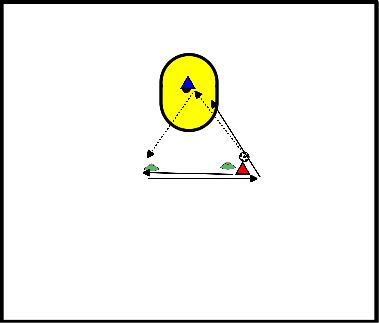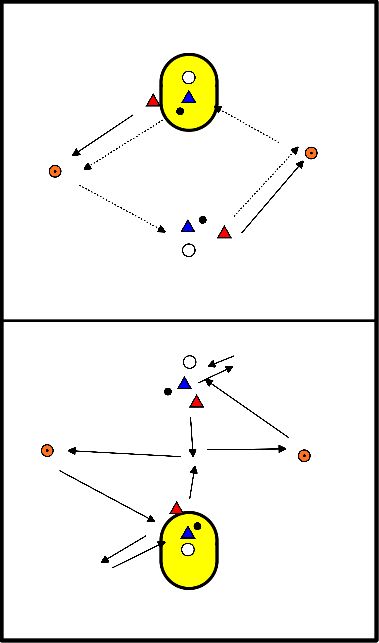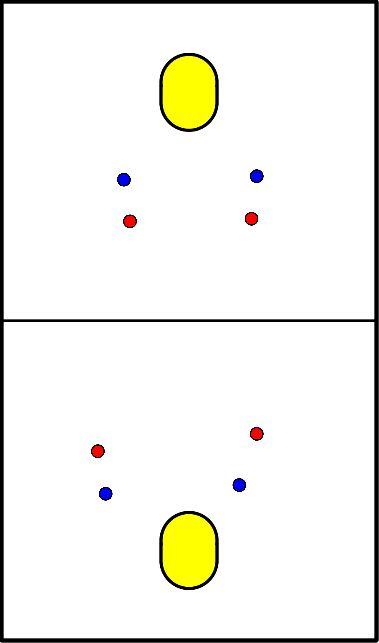Korfball drills
- 3- /4-pairs at a basket.
- Play the ball in to the basket and move to the left, get the ball back and shoot.
- Then move back to the right and take a through ball after hand change.
- Which basket scores 10x first?
- Then the same task change directions.

Per 3 or 4 at the basket:
- Using pawns, divide the attacking area around the basket into 4.
- There are players in 3 of these 4 areas.
- If 4 players, set up a rebound.
- The moment player white passes the ball to player blue, player white moves to the free area. Player blue plays on to player red, and then also starts filling in the free space.
- Note: do not let players run away too quickly, make sure they remain playable. The idea is that they make a timely attack. Walk towards the ball.
- Give a signal to shoot, the other 2 will fill in the rebound from space.
- Then play again and repeat.
- If it goes well, also try it with a defender -> let the pass be given, but then make it more difficult to get free.
- If feasible, you can also implement a support in the exercise.
Let the players think for themselves who best fills this position.
- If feasible, you can also implement a support in the exercise.
Let the players think for themselves who best fills this position.

With 4 players:
- Everyone stands at his/her pawn 5 meters from the basket. Players forming a team put themselves in the diagonal.
- One player has the ball and shoots.
- The others engage in the rebound duel - the shooter, too, if necessary.
- Whoever has the ball gets to attack as a team.
- Maximum of 2 chances.
- Who has X goals first?
With 3 players:
- The player who catches forms a team with the shooter.
- 2 against 1 to attack.
Turn after each attack.

Place 2 poles directly opposite each other.
Under each basket one player with ball and one player without.
Under each basket one player with ball and one player without.
- The player without ball runs clockwise to the cone halfway diagonally across the court.
- The ball is passed along in the run and passed to the declarer under the other basket.
- Walk-through ball follows, self-catching.
- Exercise repeats.
- Players without ball run straight at each other. After a jump they go sideways to the cone.
- There they continue without a pointer to the swerve on the other basket.
- The shot is followed by a follow-through that is self-caught. Then you switch.
- The player in give-up throws the ball away with backspin. The player without the ball runs to the ball and tries to catch it for the 2nd bounce. Make sure the ball is not thrown too far.
- After catching, turn and pass to the supplied player, followed by a swerve with a shot.
- Then run for a through ball at the other post, catching yourself.

Per 3 players at the basket:
- With pawns, divide the attacking area around the basket into 4.
- There are players in 3 of these 4 areas.
- When player white passes the ball to player blue, player white moves to the free area.
- Player blue plays through to player red and then also fills the free area.
- Give a signal on which may shoot. The other 2 go out of space to fill in the rebound.
- Then play out again and repeat.
If feasible you can also implement a support in your exercise.
Let the players think for themselves who best fills this position.
Let the players think for themselves who best fills this position.

- On a tennis court, you will play in 2 squares 2 against 2.
- Both courts are attacking.
- When intercepting, the ball must first go to the other side.
- Play with 2 teams of 2.
- Both squares are attacking squares.
- On interception, the ball must go to the other side first.

- In pairs at a post
- The shooter starts with the ball
- The shooter plays the ball into the support
- The shooter makes a hook to the left or right and gets the ball back
- The shooter shoots at goal
- The intercepted ball is played directly back to the shooter
- The shooter plays the ball back to the support
- The shooter makes a through ball
- After scoring twice, switch positions
- Everyone does this exercise 5 times
- Each pair must try to crack the code. This is a four-digit code where the sequence matters.
- Each exercise is a number; they can use this number in the code.
- When they have done 4 exercises, they pass this as the code, in the order in which they did the exercises.
- The trainer then indicates how many the players got right and how many are in, but not in the right place.
Exercises:
- 8 walk-through balls
- 5 rounds of running ladders pp
- 2 laps around the whole field
- 5 fallback balls right
- 5 safety balls left
- touch post small chance, 8 score
- 20 penalty throws
- 6 distance shots 6 m in front of the basket
- 6 distance shots 5 m behind the basket
- Players spread out in a box
- All players, except the ticker, have a ball
- The ticker tries to tap everyone.
- If a player is tagged, he or she goes to the posts to score.
- If successful, the player returns to the box.
- If a player drops the ball, they are also out.
Variations through different ways of holding the ball.

- Everyone at a basket with ball
- Other players start running and taking through balls
- After a certain score, the next

- Per 2- or 3-team
- 1 person under the basket
- Others at the pawns
- Always a pattern that the player has to run at the pawns
- End with a through-ball, drop ball or start-off

Shooting game where they get to take a card when they have scored.
- Each playing card shows a "color": clubs, spades, hearts or diamonds.
- Each color represents a fitness exercise:
- Hearts: Push-ups
- Spades: Squat
- Clubs: Burpee
- Diamonds: Lunges
- Once they have picked a card, they must first perform the corresponding exercise.
- They do this the number of times the card indicates.
- For example, Hearts 4 = push up 4 times.
- Then they may continue shooting again.
- The group with the most cards has won.








